People have this notion that the Australian Shepherd is an import from the Land Down Under, when in fact it is an all-American breed. In addition to its remarkable work ethic, something that all shepherd dogs seem to have, the Aussie is also a good-natured and affectionate hound that makes an interesting family companion especially for those in the countryside. Why is that? Well, despite efforts to have this dog learn to adapt to urbanized living, its heart and soul remain that of a working sheep dog. You can always try to make it more modern, though; but, you’ve got to be ready for any possible change in its temperament. Born to work and live with its human family, could the Aussie be the dog you’ve been looking for? Let’s find out.
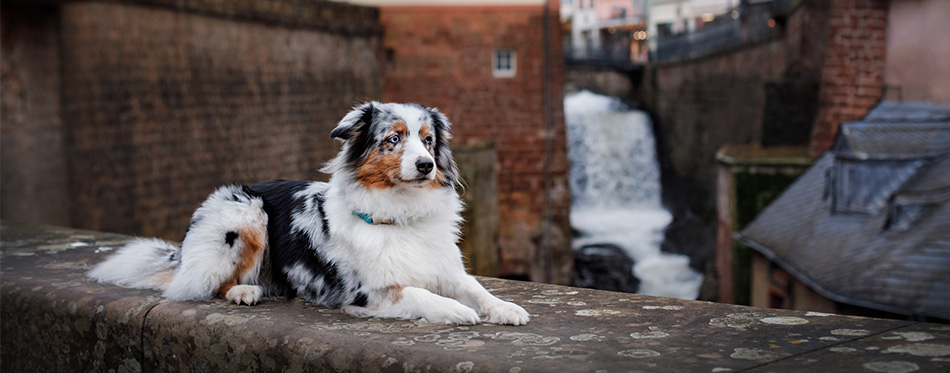
History of the Australian Shepherd
As we’ve mentioned, the Australian Shepherd is not from the Land Down Under. There is very little evidence to show the exact origins of the Aussie as these dogs were primarily chosen not from their bloodlines, but more for their working abilities.
When Spain conquered Mexico in the 16th century, many Spanish migrants brought with them the Churra, an Iberian breed of sheep that is found in Castile and Leon in northwestern Spain. This livestock provided both food and fiber for the Spanish soldiers. Along with these ewes and lambs were Spanish herding dogs, specifically the Carea Leones which were natives of the same region where the Churra originated. When these Spanish conquerors and migrants moved northwards towards the Sierra Nevada region of present-day United States, they brought with them their livestock and their herding dogs. The Carea Leones is, thus, believed to be one of the breeds that are included into the making of the Australian Shepherd.
During the Gold Rush in the US West Coast in the 19th century, European immigrants from the East Coast moved westwards, bringing with them their own herding dogs which could perhaps have included the Border Collie and the English Shepherd. At about the same time, immigrants from Europe traveling by way of the Pacific via Australia landed on the western shores of the US. They also brought with them sheepherding dogs.
It is believed that the interbreeding of herding dogs from the south, east, and west resulted in the creation of the Australian Shepherd. The dog’s remarkable ability to herd livestock in the harsh Rocky Mountain terrain proved invaluable for owners and ranchers that they began breeding these dogs to sell to ranchers from distant areas of the region. No one knows exactly why they called it the Australian Shepherd, although one very popular theory states that it was named after the sheep for which these dogs herded (the same sheep that European immigrants brought with them by way of Australia).
Another theory is that the name came from the general observation that majority of dogs that came from the Land Down Under had blue merle color. As such, any dog that had such a color was called “Australian”.
The Australian Shepherd Genealogy Chart outlines the relationship between and among the early dogs of the American West. It gives wannabe owners of the Aussie what they should expect from the dog. Owing to the ruggedness of the terrain of the American West, the Aussie had to be very hardy especially against severe weather. It also needs to be very athletic, agile, and super-fast. The Aussie, as a working dog, also had to be intelligent yet fully capable of independent thinking and display flexibility. While independent-mindedness is desired, the Aussie should still be able to retain its biddable nature. It should also be an endurance dog as herding flock in the American West can usually mean covering over a hundred miles at a time.
Today, the Aussie sits at number 17 in AKC’s most popular dogs. They are no longer just limited to the work of herders. Like the other herding dogs such as the German Shepherd, the Australian Shepherd has found other employment as well. Many are serving as search and rescue dogs, as therapy dogs, and as detection dogs. Others are trained to be excellent disaster dogs, service dogs, and guide dogs.
Quick Facts
Despite the fact that there are still grey areas in what we know about the Aussie as a breed except that it is a really intelligent, tough, workaholic dog, you’d be glad to know that we have quite a handful of information that might help you gain a much better understanding of this dog.
- The male Aussie stands about 20 to 23 inches while the female can be anywhere from 18 to 21 inches.
- When it comes to the Aussie’s weight, males outweigh their female counterparts by about 5 to 10 lbs as they can tip the scales at 50 to 65 lbs while females can come in at 45 to 55 lbs.
- It has a lifespan reaching at least a dozen years, often maxing out at 16.
- Their sense of playtime may not necessarily equate to fun.
- They are intelligent dogs, but not really as intelligent as the top 3 in the world rankings for the most intelligent dog breeds (regardless of what they say, no other dog breed can topple the Border Collie, Poodle, and GSD).
- Their herding instinct is strong and as such it may not be a good idea to let them play with small kids and small animals.
- Australian Shepherds shed a lot and are not considered hypoallergenic (technically, there is no such thing as hypoallergenic; keep that in mind).
- There are 4 recognized colors of the Aussie: solid black, solid liver or red, blue merle, and liver or red merle.
- Each color of the Aussie can have white markings or copper points on its legs, chest, and face.
- An Aussie with white on or around its ears is often taken as a sign that the dog has an increased risk of developing deafness.
- Aussies with excessive white color on their face and ears are considered to be at risk for skin cancer secondary to sunburn.
- There are three color alleles or gene variants for Aussies. Black is considered dominant while Red is generally considered as recessive. Merle is also dominant.
- The merle coloring is considered as the signature coat pattern of the Australian Shepherd.
- Breeding two merle Aussies will have 1 of 4 puppies that will have two copies of the dominant merle gene. These puppies will have blue irises and white coat. They can also be blind, deaf, or even both. The reason for the blindness and /or deafness in this homozygous merle Aussie is that the gene disrupts the normal process of pigmentation.
- Black Aussies as well as blue merle Australian shepherds will always have black eye rims, noses, and lips and brown eyes.
- Red Aussies and red merle Aussies will have brown or liver-colored eye rims, noses, and lips and amber eyes.
- Aussies are fondly called as the “ghost eye” dog because of the color of their eyes which are heterochromatic (having eyes with different colors).
- Australian Shepherds can have bobbed or partially bobbed tails.
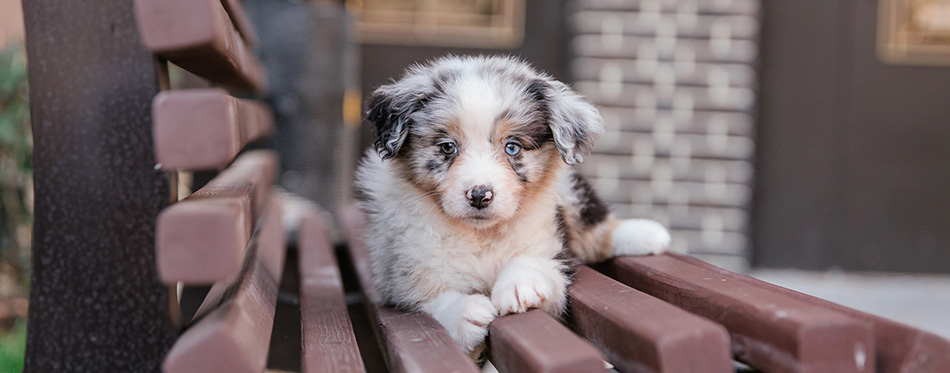
Things You Should Know
Some potential dog owners have this line of thinking that all dogs are just the same. You give them food and shelter and that’s about it. If you share this line of thinking, then we can tell you with all honesty that the Australian Shepherd is not for you. It was bred specifically for the purpose of herding livestock over some of the most inhospitable terrains of this country. Moreover, their descendants were no pushovers, too, when it comes to their work ethic. As such, they require a great deal of attention, training, and exercise.
It is important to emphasize this because, as adorable the work ethics of the Aussie is, in the hands of an ill-equipped and incompetent (forgive the term) dog owner, this dog can easily become a destructive four-legged hurricane in one’s home. The ending of the story remains the same, however. Since the dog owner simply failed to meet the unique needs of the dog, the Aussie eventually finds itself in an animal shelter where hopefully someone who is more qualified can adopt it.
We hate seeing man’s best friend in such conditions. It is for this reason that we implore you to take time to understand, digest, and appreciate the implications of caring for an Australian Shepherd.
Training
Australian Shepherds are, without a doubt, one of the sturdiest and most devoted working dogs in this part of the globe. They may not have the level of intelligence of the Border Collie, German Shepherd, or even the Poodle, but they are intelligent nonetheless. How else can you expect them to perform their job as both a herder and a protector of their family’s livestock if they do not have the natural intelligence to make quick canine decisions?
You should remember that the Aussie is bred not for its bloodlines, but purely for its ability to work. And one of the fundamental requirements for all working dogs is intelligence. And oh, we almost forgot. They have to be independent-minded, too. They need to be able to make quick decisions on what to do when presented with a situation. They don’t need to go to their masters every time a situation arises. They have to decide for themselves. And for them to do this they need to have excellent critical thinking skills. And this is what we mean by innate canine intelligence.
So what do all of these mean? It means you have to recognize, appreciate, and respect this dog’s intelligence and admirable decision-making skills. The only way you can do this is by training it.
Start with housebreaking your dog. It is important that it learns the ground rules in and around your home. Once you’re done, you can get on with basic obedience training. This typically comprises teaching the Aussie to respond in a manner that you wish it to when given a verbal cue. You need to develop your very own system of commands that the dog will have to follow and adhere to. These are crucial to ensure both order in your life and safety for your pet.
Australian Shepherds are smart. It would be wise to teach them a variety of tricks other than simply following your commands. You can take your cue from what they love doing in the field. In case you don’t know, Aussies are well-regarded when it comes to playing a game of Frisbee. If you can also create a mini obstacle course or any other activity where it can display its agility, then that would be fine, too. You can even teach the Aussie to perform some of the chores at home. It’s that intelligent. Check out our guides on dog training books and dog frisbees for more info.
Feeding
Taking care of the nutritional needs of the Aussie isn’t that different from other dogs. While they do require some modifications in their diet owing to some health concerns that are quite common among these dogs, they generally require high-calorie, high-protein diets that put emphasis on premium animal-based proteins. Though it is perfectly okay to give them dog food that contains plant-based proteins such as pea protein, under no circumstance should these types of proteins be on the top of the ingredient list. If you’re a vegan, forget about owning an Aussie as it will not really benefit from zero-meat diet. Remember, even though domestic dogs have evolved through the ages from their wild canine ancestors, their guts remain essentially the same. It is still the gut of a predator.
Calorie-dense dog food is a fundamental requirement as the Aussie is a highly energetic pooch. a typical 50-lb Aussie working with moderate to high intensity needs about 2,100 to 2,900 calories every day. This can be divided into 3 meals. Of course, this is just an estimation. If the Aussie is not really working that much, it may only need about 1,100 to 1,600 calories per day. The point is to always consult with your veterinarian so that the dog’s weight, activity level, health status, and life stage can be factored into its nutritional requirements.
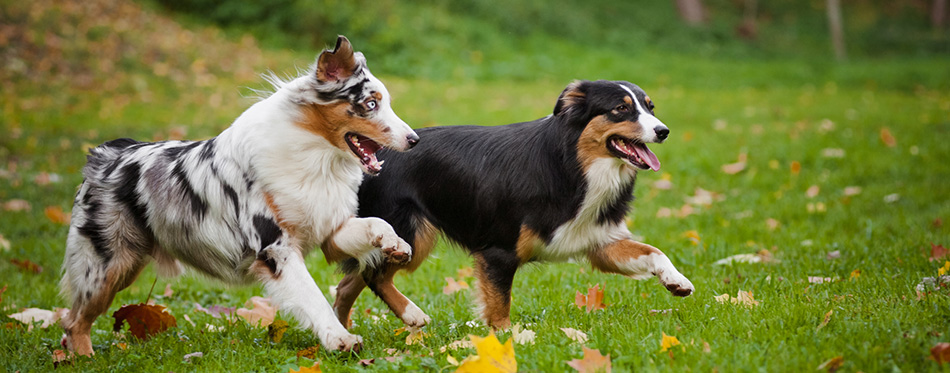
Exercise
To say that the Australian Shepherd needs daily exercise is obviously an understatement. It lives for it. When it was bred by Basque shepherds in the American West, they did not create a lap dog that will spend the whole day lying around in the house or in the yard. They created a dog that will go up the Rockies and herd their flock. It was bred with only one thing in mind: to work. And since not everyone today has a farm to begin with, they’d have to be more creative in giving the Aussie some form of ‘work’. Exercise is the best form of work for these dogs.
Don’t ever think that they will get tired. One of the qualities that the early breeders of this dog sought in their herding dog is endurance. They can run miles all day long. They can drive and guard sheep, running up and down the fields just to keep their flock in order and safe. If humans were to perform these tasks themselves, they’d die of exhaustion. Not the Australian Shepherd. It is for this reason that the Aussie best responds to someone who has the stamina and endurance to match that of the dog. You’ve got to be the outdoorsy type of person and one who simply hates having his butt glued to a seat for even a few minutes.
When it comes to exercise, Australian Shepherds love catching and fetching the Frisbee. They also excel in flyball, although they won’t mind walking for a few hours a couple of times every day. They’d run with you or they can run along while you ride the bike.
In addition to exercise, mental stimulation is a must-have for the Aussie. So if it is not outdoors playing, exercising, or training, the Aussie will be whiling its time solving problems in your house. You may not like what it will do to your bed, couch, or carpet, but it is just its way of telling you to give it something to do. It is therefore imperative that you give it puzzle toys to keep it really busy.
Socialization
One of the characteristic traits of herding dogs is their protectiveness. And this is very strong in the Aussie. If you’re looking for a dog that can be buddy-buddy with other persons, this isn’t for you. Even with early socialization, the Australian Shepherd’s protective streak is so strong that it will always be wary of strangers. It will bark, and boy does it really bark! Apartment dwellers should think many times before taking an Aussie into their abode as this dog is very suspicious of anything and anyone it’s not familiar with.
While it may not be friendly with strangers, it treats its family very differently. Its family is everything to this dog. It is perfect for children with its high energy levels that it can use for playing. However, it still has the tendency to round up its family especially if it senses that they are in danger or are being threatened. Cats and other pets may not have that much luck with the Aussie around.
Grooming
The coat of the Australian Shepherd may not be as dense as other dog breeds like the Rough Collie, but this doesn’t mean you can skip brushing it regularly. Once or twice a week is typically considered enough for this dog. However, given its tendency to shed heavily, it is imperative that you brush its coat on a more frequent basis. Warm baths should also be given once a month during the shedding season. Outside of it, bathing can be done only when the Aussie gets really dirty. Take a look at our review of dog bathtubs for more options.
Its teeth need daily cleaning and brushing, however. As for its nails, these need to be clipped every month or whenever you start hearing scratching noises as the dog walks. The ears have to be inspected and cleaned using an appropriate solution every 10 to 14 days. Find out more about dog toothbrushes, dog toothpaste and dog shedding brushes here.
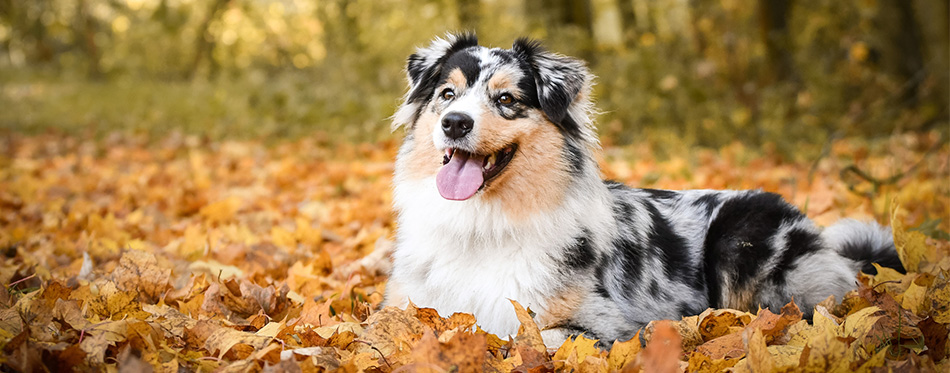
Health
Double merle Aussies are very prone to eye defects and problems because of the effect of having two copies of the dominant merle gene in their system. This can lead to coloboma which is defined by the absence of certain structures in the dog’s eye. Even non-double merle Aussies also get eye problems such as cataracts, detached retinas, and progressive retinal atrophy. Although rare, it is still possible that the Aussie will get the Collie Eye Anomaly which is a disease that affects the sclera, choroid, and retina of both the dog’s eyes.
In addition to eye problems, skin disorders, respiratory problems, and hip dysplasia may also be present in an Aussie. Otherwise, this dog is a healthy one.
Get an Australian Shepherd if and only if you…
- Are as physically active as a professional athlete or an extreme outdoor adventurer
- Can devote more than 2 hours every day to walk, run, jog, and play with the dog
- Know how to apply the principles of positive reinforcement in canine training
- Are familiar and know how to put a dog in advanced training like agility, tracking, and the like
- Own a property with large open space or live in rural areas
Forget the Aussie if you…
- You’re as lazy as any other self-confessed couch potato
- Hate training dogs or don’t really care much about training
- Find your living space too cramped
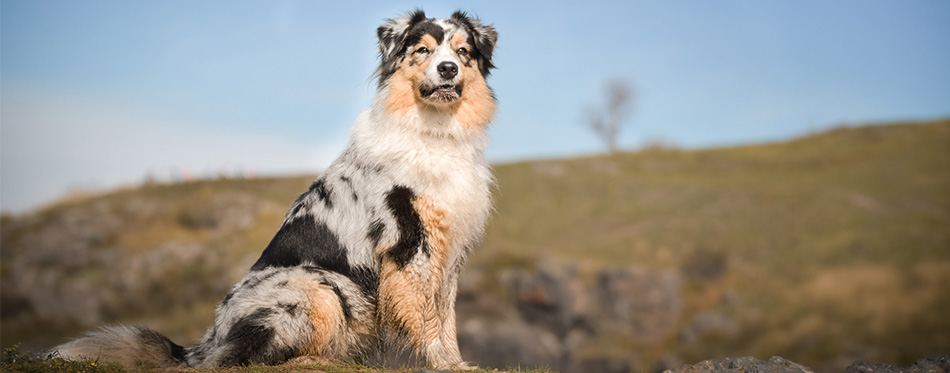
Temperament
They may be cautious and reserved with those they are not familiar with, but the Australian Shepherd has a devoted, kind, and loving streak to it that it can readily show to those that it considers its family. These dogs are exceptionally loyal and affectionate of their owners and their children. They’re like Velcro that loves to be attached or stay close to its owners. Its intelligence, trainability, and flexibility necessitate the provision of a number of ‘jobs’ for the dog. If this cannot be provided, it can be a really destructive force.
The Aussie is a herding dog that takes on many of the fine qualities of dogs of its class. It has the high energy level of a Border Collie that requires plenty of work for it to feel happy and contented. If you can see yourself leading a very active lifestyle, then this dog is for you.
Sources:
- Australian Shepherd Dogs – PetMD
- Australian Shepherd – Washington University in St. Louis

